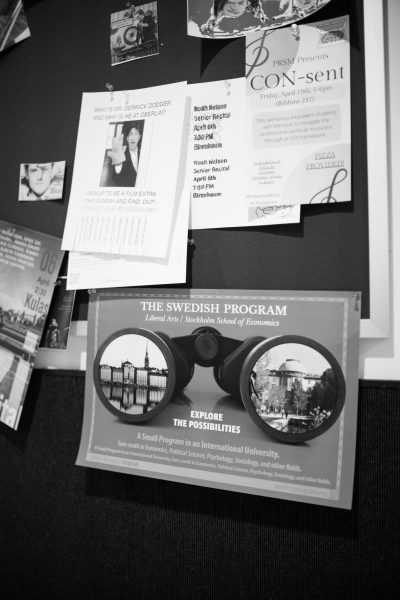Oberlin Churches Should Consider Pay-it-Forward Lighting Program
Lighting retrofits are becoming accessible to more Oberlin churches through a highly successful program that combines rebates provided by the city with the altruistic nature of churches. The Pay-it-Forward Program strengthens ties between Oberlin churches, reduces carbon dioxide emissions, and — with a little help from Review readers — has the potential to do the same in other communities as well.
The program was born after the First Church in Oberlin, United Church of Christ, qualified for a rebate of approximately $1,800 by switching their lighting from incandescent bulbs to LEDs, according to Eugene Matthews, co-chair of First Church’s “green team” and member of their facilities committee. Instead of absorbing this sum back into their budget, the church chose to use the money to pay for more lighting retrofits, first at Rust United Methodist Church, and later the Unitarian Universalist Fellowship. These churches in turn qualified for rebates that could be passed onto other churches. Today, seven churches have taken part in the program.
The rebates the program relies on are generated through Oberlin’s utility rebates and “super rebates” funded by the city of Oberlin, which match the rebates given by the utility. Together, these rebates often pay back 50–75 percent of the cost of the bulbs, according to Matthews.
“The idea is to address each one of the churches with the hope that as they look nice and beautiful and lit up inside, you can then talk to the parishioners about having the same thing done on their home,” said Greg Jones, who works for Providing Oberlin With Efficiency Responsibly, Oberlin’s community energy conservation nonprofit. Jones is Oberlin’s Energy Advocate and a key player in facilitating the Pay-it-Forward Program. He highlights how Oberlin residents will be more open to energy retrofits within their homes after they see an energy efficiency measure successfully implemented by a source they trust — their church. In essence, the Pay-it-Forward Program has the potential to reduce carbon dioxide emissions by improving energy efficiency not only in churches but also throughout the broader Oberlin community.
Although POWER facilitates the program, churches decide which church to pass their rebate on to and, alternatively, have the option to keep the rebate if they need the money. That being said, Jones has worked to expand the program beyond the city’s main religious establishments. In total, he estimates Oberlin has over 25 churches.
The system is crafted so that the pool of rebate money will continue to
be replenished.
“We want to zig-zag it a little,” Jones said, describing how he suggests churches choose to pass rebates onto a church that differs from them in size. Bigger, more financially-stable churches can choose to use their own money to bridge any financial gaps caused when small churches do not receive rebates large enough to cover the full cost of a retrofit in a church that is larger than them.
In the event that the “zig-zag” method isn’t enough to sustain the pool of rebate money, Jones has located an external backup funding source. A set of accounts managed by Oberlin students known as the Green EDGE Fund can act as a financial backstop for the program, ensuring that every church — regardless of its size or financial situation — has full access to the program.
Surprisingly, the biggest problem the program faces is difficulty convincing churches to participate, simply because it seems too good to be true. Churches tend to take a while to warm up to the idea that someone else would pay for their lighting retrofit. It took almost a year for Rust United Methodist Church to accept the First Church’s rebate money due to confusion about the sequence of payments.
This was the experience of Thom Colon, president of the board of Oberlin’s Unitarian Universalist Fellowship.
“It actually took me a while to understand what our responsibility was and what expectations people had for us,” Colon said. However, once the program was fully explained to him, Colon was all on board. “It’s kind of a win-win. Somebody’s going to give you money to make an improvement, and all you have to do is when you get the reward you just have to share it. I mean that’s kind of a church thing anyway.”
The fact that the program strengthens bonds between Oberlin churches of different faiths and demographics is just as much a draw for participants as the lighting retrofits.
“It’s really not so much about energy conservation as it is about community, about churches helping churches,” Matthews aptly said.
The success of the Pay-it-Forward Program has sparked interest even beyond Oberlin. In fact, Jones has received inquiries about it from Cleveland and Avon.
“I always think of whatever we’re doing here as a prototype for what other communities can look to do,” Jones said. This prototype has exceeded expectations.
Extending the program’s format beyond Oberlin is exactly what needs to happen to fully develop this concept. Oberlin students: Start a Pay-it-Forward Program in your hometown that builds off the prototype modeled here. Oberlin churches: Contact Greg Jones to get in line to have a rebate passed on to you. Or don’t wait — pay to switch your light to LEDs, and be the church to pay a rebate forward. Adapt the basic outline of the program to your circumstances.
Pay-it-forward programs don’t just have to apply to LED retrofits, either. Any energy efficiency change that qualifies for a rebate could be “paid forward.” Participants don’t have to be churches either. Why not pass rebates between schools? Or even whole towns? Let’s think outside the box — and combat climate change and build community while we’re at it.


